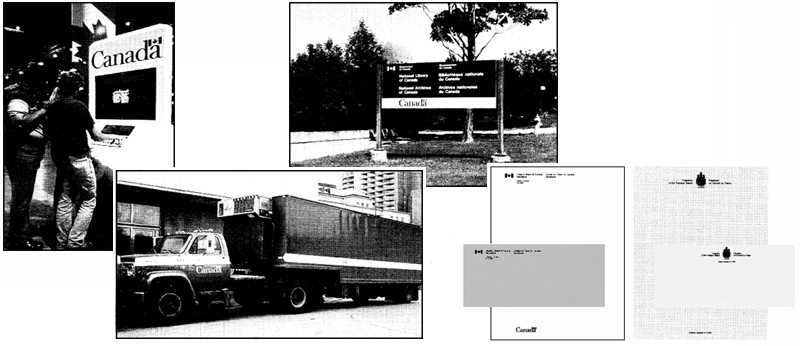Source: Treasury Board of Canada Secretariat
Background
As with corporate identity programs generally, the Federal ldentity Program (FIP) is based on the use of corporate symbols applied in conjunction with organizational titles. The corporate signatures serve to identify institutions as part of the Government of Canada rather than as separate, independent entities. The origins of the government's corporate identity can be traced to the following events.
1921 The Canadian Coat of Arms was adopted by royal proclamation and introduced on government stationery. The colours red and white were declared to be Canada's official colours.
1965 The Canadian flag was adopted by royal proclamation. The maple leaf was confirmed as an official national symbol.
1969 The Official Languages Act was proclaimed, establishing the principle of equality of English and French.
1969 The Task Force on Government Information reported that the government was failing to make its presence known and that important federal programs were being carried out without the public being aware of their sponsorship.
In its report "To know and be known', the Task Force observed that organizations did not project a uniform, clearly identifiable image as functional parts of the same government. Many organizational titles failed to distinguish clearly public from private, or federal from provincial. Furthermore, through the use of different and uncoordinated symbols - many of very poor design - each organization identified itself as a separate entity.
1970 The creation of the Federal ldentity Program was announced in the House of Commons. Standardization and clear identification of federal activities were cited as main objectives. Information Canada, a new agency, was made responsible to develop and implement the program.
1974 Treasury Board approved the first policy guidelines that included the use of the two official languages and a management system for the development and implementation of the program.
1976 Following the demise of Information Canada, the Treasury Board Secretariat was given responsibility for FIP.
1978 Treasury Board issued a comprehensive policy and design standards.
During the 80s, FIP underwent several reviews that resulted in changes to the use of symbols. In 1980 the "Canada" wordmark was established as the global identifier of the government. In 1987 the federal emblem (bar and maple leaf) was replaced by the Canadian flag. This means that the Coat of Arms, the flag, and the "Canada" wordmark are now the corporate symbols of the government.
Rationale
Although not prepared for that purpose, the rationale for FIP was well expressed in the 1981 report of the Parliamentary Task Force on Federal-Provincial Fiscal Arrangements. The following statement could apply to all aspects of federal identity:
"...spending without federal presence is not just frustration for the politician, it is also a denial of the citizen's right to see the government's work and to judge it. When the federal role is not evident, it cannot be assessed. Visibility involves a search for the chance to take the credit, but at the same time, a willingness to shoulder the blame. As politicians, therefore, we reject the simplistic view that a concern for visibility is no more than public relations for its own sake. Answerability of federal MPs to the public is the other side of the coin from accountability of ministers to Parliament, and a government that is not visible cannot be answerable".
In summary, federal programs, services and contributions should be recognizable to the public in order for the government to be accountable. From a practical point of view, FIP represents an important aspect of service to the public. The program's guidelines are based on the use of plain, non-bureaucratic language, functional graphic design and a systems approach in identifying government services.
Scope
The Federal Identity Program is considered to be one of the largest corporate identity programs undertaken by a national government. An estimated 18,000 facilities, 16,000 government vehicles, and a multitude of forms, stationery items, published material and advertisements are identified in accordance with FIP guidelines. The program is being applied by over 100 federal institutions in all regions of Canada as well as abroad.
A global viewpoint
An aspect worth noting is the relationship between the visual identity of the government and that of the century. The report to the 1969 Task Force on Government Information first referred to this aspect. The report said:
'A great deal of the responsibility for the image of a country rests with government. There are scores of ways in which government is instantly recognized. They range from the flag and the appearance of government buildings the stationery and letterheads, advertisements, insignia on government vehicles and so on. Abroad, the distinction between government and Canada merges into a single image". The report called it "l'image Canada".
In 1988 this concept was addressed at an international design exhibition at the Centre Pompidou in Paris. Under the theme "Images d'utilité publique", the exhibition examined how the state and public authorities and organizations communicate with people and how information design directly affects the functioning and quality of society. The Federal ldentity Program was among the case studies from different countries that demonstrated national, civic and cultural visual identities. Internationally, the Program is well recognized among corporate identity and design consultants.
Behind The Design takes a look interesting tidbits in the world of design. From the history of identities to pictogenes, geons and the science of visual communication. Follow us as we explore those things you may never would have thought of.





